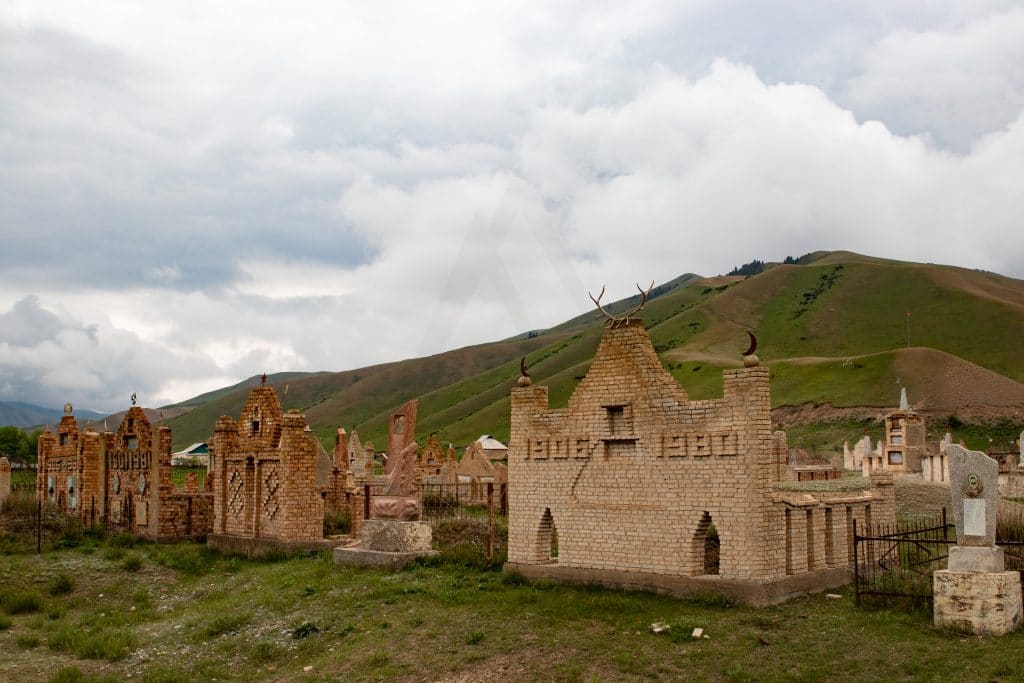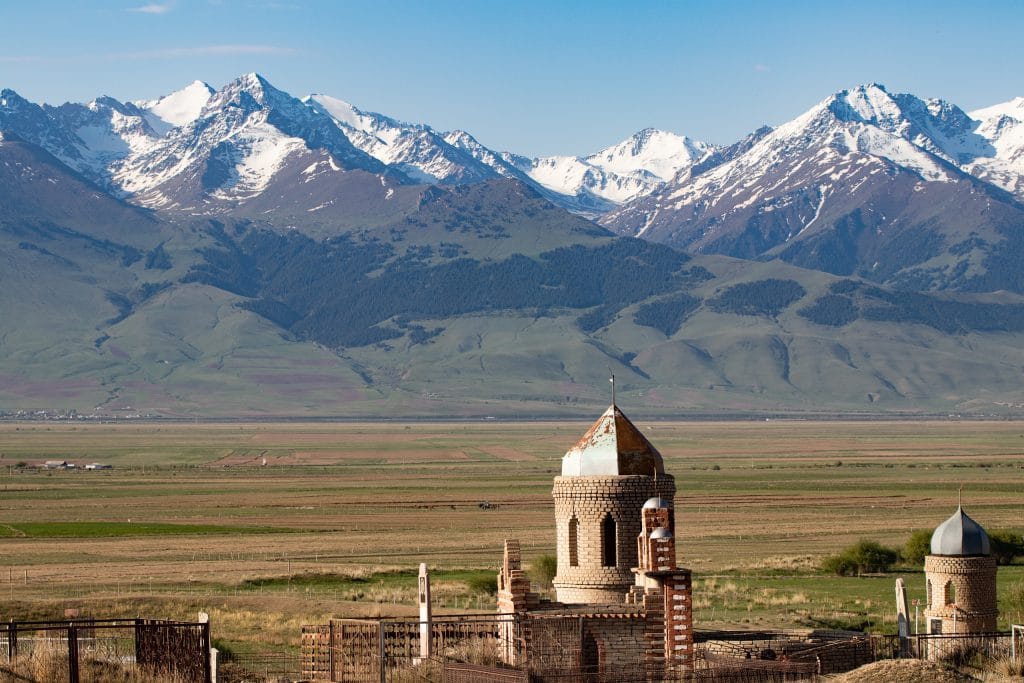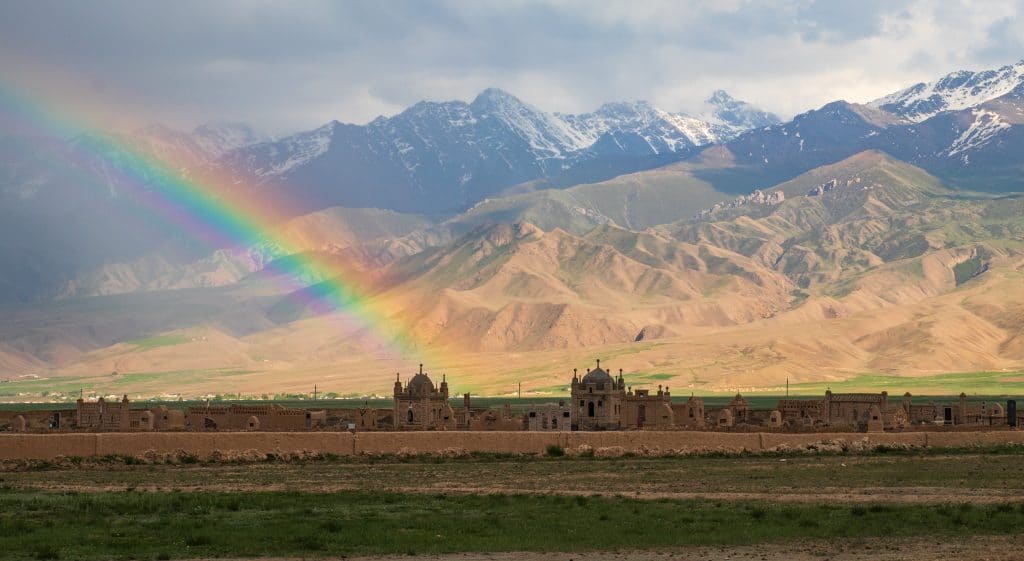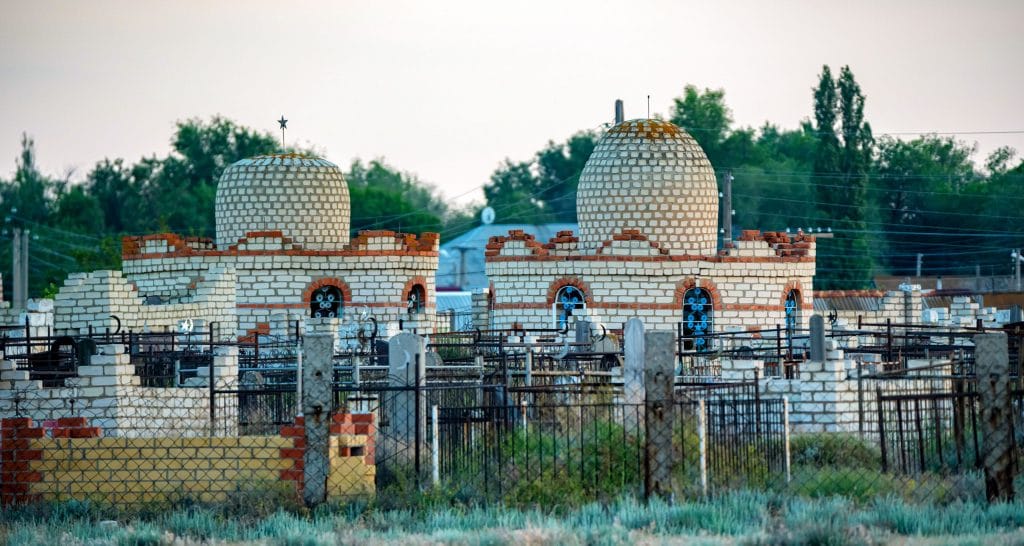Kyrgyz funeral traditions
Funeral Traditions in Kyrgyzstan
While driving around Kyrgyzstan, you will surely notice cemeteries on the outskirts of almost every town or village. Kyrgyz funeral traditions include beliefs and rituals from both the Muslim and pre-Islamic eras.
Funerals are traditionally large, costly affairs and the graves are sometimes decorated with marble or patterned brick tiles and topped with the Muslim crescent moon. In more rural parts and places where the Islamic influence has been lesser, the crescent is often replaced by some animal characters or for example the horns or antlers of an animal.
The funeral in Kyrgyzstan comprises steps of deeply rooted rituals, including the death announcement, ablution of the body, mourning, and burial, along with many other traditional customs that honour the deceased.
The funeral process in Kyrgyzstan involves a large number of people, primarily close family, extended relatives, neighbours, and friends, who come together to help with various practical matters during the mourning period. Death is seen as a collective responsibility, requiring the efforts of the entire extended family, often including relatives up to the cousin level and beyond.
Two yurts are set up at the home of the deceased, one for female mourners, where the body is placed, and another for guests. Close relatives sit inside the yurt facing the deceased, separated by a curtain. Visitors enter from behind the grieving family, offering their farewells to the departed by embracing and mourning with the close relative.

Saying Goodbye to the Deceased
When a person passes away, their close relatives and neighbours are informed first. Typically, the neighbors arrive first to comfort the person who discovered the death and to stay with them until the police, ambulance, or relatives arrive.
Once the death is confirmed, the body is immediately transported to the deceased’s village or homeland, where their ancestors are usually buried. Along with the body, personal belongings, such as clothes, are taken to be hung on the yurt. The body is transported by truck, accompanied by close relatives and anyone who hears the news.

By tradition, people express their grief openly and guests will begin crying long before they reach the home of the deceased. One of the significant rituals during the funeral is called “koshok” (lamentations in the form of verses).
Women in the yurt cry loudly and sing “koshok”, while men mourn outside. The tradition of mourning cry originates from Tengrism and is preserved among the Kyrgyz to this day. Koshok is performed mainly by women and are even professional women who can be hired for it. After three days of public mourning, the dead person is buried, wrapped in white cloth according to Islamic beliefs. If the close relatives do not cry loudly, guests might judge one.
The men mourn outside the yurt, crying loudly. The closest male relatives of the deceased lean against the yurt, raising their voices in grief. On the day of mourning, everyone keeps their traditional headwear on throughout the day. Close relatives, especially the women, continue to wear their zholuk (scarf) for the next 40 days. The widow must also wear dark-coloured clothing for at least a year after the funeral.
A message about the death is sent to all distant relatives, acquaintances, and friends. As the men approach the yurt, they mourn loudly. After this, the women enter the yurt and begin their mourning and crying. Before anyone enters, the family elder (Aksakal) offers a prayer and remembrance for the deceased outside the yurt.
Burying the body to the cemetery
According to custom, women are not allowed at the burial, so only men go to the graveyard to carry the body and place it in the grave. The women remain at the house, serving the guests. After the body is laid to rest, the yurt is taken down the next day, and everyone returns home by the next day.
Officially, the funeral rites are considered completed for this day with the next Friday, then the week seven days, the fortieth day, and one-year memorials being held with the sacrifices of horse or sheep at least. However, the close relatives of the deceased continue to remember them and regularly turn to the Creator in prayer.
Zhetilik (seven days), Kyrky (fortieth days), and one-year memorials
“Seven days” (жетилиги) memorial, held seven days after the death of a person. It is a time for family and close relatives to gather and pray for the deceased. The forty days” (кыркы) memorial, is held seven days after the death of a person. It is a time for family and close relatives to gather and pray for the deceased. The one-year memorial (also called “Ash”) takes place one year after the death. This is often an important commemoration, where family and relatives gather for a larger memorial feast to honour the deceased.
There is also Zhumalyk, the first Friday after the death, which is observed with the sacrifice of a sheep or goat (Kan Chygaryuu – the spilling of blood). These rituals are an important part of cultural and spiritual traditions, serving to honour the deceased, strengthen family bonds, and seek blessings for the soul of the departed.


Ash Memorial gatherings
Ash is a ceremony that Kyrgyz families hold to remember and pray for a loved one who has passed away. It typically takes place on important anniversaries of the death, such as the 7th day, 40th day, 100th day, and 1st year after the person’s passing. This ritual is an essential part of Kyrgyz mourning and remembrance practices, combining elements of both spirituality and community bonding.
During the ash maybe also practiced the visiting of the tombs to seek blessings and pay respects. The feast is centered around prayers, for the soul of the deceased. Mullahs (Islamic clerics) or elders often lead the prayers. These prayers are meant to bless the soul of the deceased and ask for peace in the afterlife.
The important part of the Ash is the gathering of family and friends. The Ash feast brings together relatives, neighbours, and friends of the deceased to remember and honor them. It is a time of solidarity and support for the grieving family.
In modern times, another formal memorial gathering is often held in cafes, especially in larger cities. If the deceased had friends or relatives in different locations who could not attend the burial, multiple gatherings might be organized.
Dastorkon, the funeral table
Dastorkon, a table is always prepared from the beginning of the funeral. The guests continue to visit the home of the deceased, where the widow, children, or closest relatives receive them. Upon arrival, guests mourn loudly and then sit for tea before departing. In some cases, it is expected that the host serves a hot meal or offers a symbolic gift, such as a scarf or a traditional Kyrgyz hat (kalpak), in return.
Traditional dishes are served such as like beshbarmak (boiled meat with noodles), plov (rice pilaf), samsa (savory pastries), and sometimes special dishes like boorsok (fried dough) the guests. This act of feeding people is considered a charitable deed, the belief that “the soul must not go hungry.”, and as giving food to others is believed to bring blessings to the soul of the deceased. A sacrificial animal is slaughtered and distributed among the guests.
Financial Burden of Kyrgyz Funerals
The financial burden of Kyrgyz funerals is significant. Expenses begin with purchasing livestock for sacrifices, preparing elaborate meals, and hosting guests daily. It is also customary to send visitors home with leftover food or a small gift from the memorial table. It is common for the Kyrgyz families to spend from $1000 to $ 10,000.
Although guests usually offer monetary support to the grieving family, these contributions could vary from as little as $5 to $100, depending on the guest’s financial ability and their closeness to the deceased. Sometimes guests just bring sweets, bread and something for the table instead of money and certainly get another in return when leaving.
The main funeral expenses fall on the children of the deceased, though in some cases, the relatives also provide financial support. However, once the funeral rites conclude, extended relatives return to their normal lives, leaving the immediate family to cope on their own.
A Burden Over Mourning
A striking part of Kyrgyz mourning traditions is that the closest ones often have little time to grieve. With a constant flow of guests to serve, what is meant to be a source of support can sometimes feel more like an obligation to focus on hosting rather than personal mourning.
The family should let the dead go with respect, therefore following the funeral traditions requires generous sums of money, with the cow and horse being the largest expenses in the southern region of Kyrgyzstan the bulb is sacrificed instead of a horse.
Learn more about Kyrgyz Culture
Kyrgyz wedding customs
Kyrgyz Crafts
Kyrgyz national games
Page updated 10.3.2025